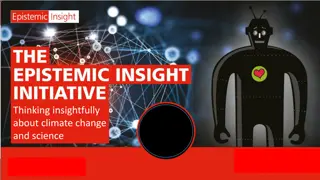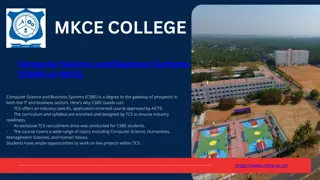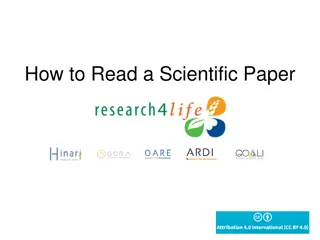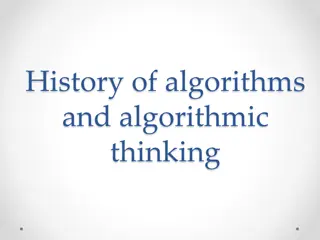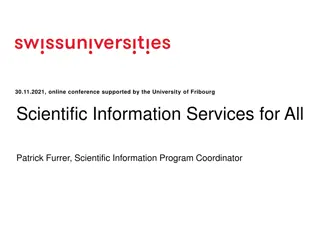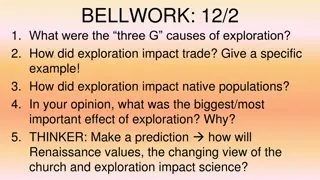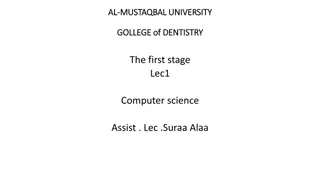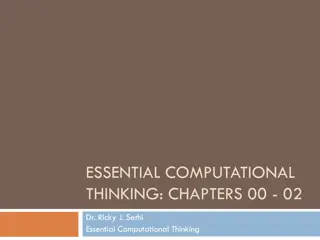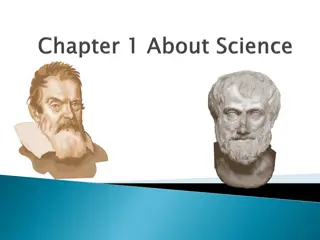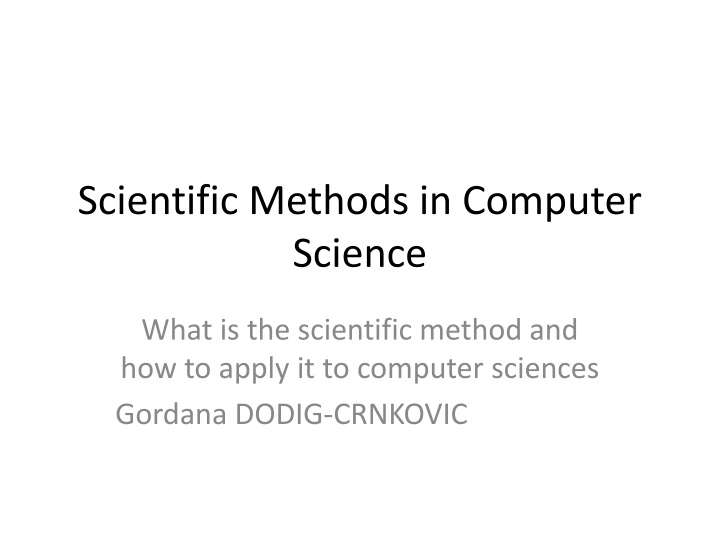
Applying Scientific Methods in Computer Science - An Overview
Explore how the scientific method is applied in computer science, encompassing interdisciplinary areas and the evolving nature of this young discipline. Discover the foundations drawn from various fields and the integration of theory and practice within computer sciences.
Download Presentation

Please find below an Image/Link to download the presentation.
The content on the website is provided AS IS for your information and personal use only. It may not be sold, licensed, or shared on other websites without obtaining consent from the author. If you encounter any issues during the download, it is possible that the publisher has removed the file from their server.
You are allowed to download the files provided on this website for personal or commercial use, subject to the condition that they are used lawfully. All files are the property of their respective owners.
The content on the website is provided AS IS for your information and personal use only. It may not be sold, licensed, or shared on other websites without obtaining consent from the author.
E N D
Presentation Transcript
Scientific Methods in Computer Science What is the scientific method and how to apply it to computer sciences Gordana DODIG-CRNKOVIC
The sciences It is not so obviousthat the Computer Science qualifies as science in a sense traditional theory of science defines the term. Computer Science (CS) is a young discipline and necessarily starting from the outset very different from mathematics, physics classic sciences have their origins in the philosophy of ancient Greece.
Computer sciences (CS) Emerging 1940's, CS has other already existing sciences in the background Computer Science draws its foundations from a wide variety of disciplines Study of Computer Science requires concepts from many different fields. integrates theory and practice, abstraction (general) and design (specific).
Computer Sciences has many areas http://dl.acm.org/ccs/ccs.cfm
The context of sciences Logic and mathematics are important for all sciences They are very essential for physics, less important for chemistry and biology Inside the central region logic is not only the tool used to make conclusions
Sciences Belonging to Several Fields Many of the modern sciences are of interdisciplinary, eclectic type It can be seen as a result of the fact that the communications across the borders of different scientific fields are nowadays much easier and more intense than before Computer Science for example includes the field of artificial intelligence that has its roots in mathematical logic and mathematics but uses physics, chemistry and biology and even has parts where medicine and psychology are very important
Pridigim shift on sciences We should, by the way, be prepared for some radical, and perhaps surprising, transformations of the disciplinary structure of science (technology included) as information processing pervades it. In particular, as we become more aware of the detailed information processes that go on in doing science, the sciences will find themselves increasingly taking a meta-position, in which doing science (observing, experimenting, theorizing, testing, archiving,) will involve understanding these information processes, and building systems that do the object-level science. Then the boundaries between the enterprise of science as a whole (the acquisition and organization of knowledge of the world) and AI (the understanding of how knowledge is acquired and organized) will become increasingly fuzzy Allen Newell, Artif. Intell. 25 (1985)
The Scientific Method The scientific method is the logical scheme used by scientists searching for answers to the questions posed within science. Scientific method is used to produce scientific theories, including both scientific meta- theories (theories about theories) as well as the theories used to design the tools for producing theories (instruments, algorithms, etc).
Steps (simplified) 1. Pose the question in the context of existing knowledge (theory & observations) 2. Formulate a hypothesis as a tentative answer 3. Deduce consequences and make predictions 4. Test the hypothesis in a specific experiment/theory field. The new hypothesis must prove to fit in the existing world-view
Warning In case the hypothesis leads to contradictions and demands a radical change in the existing theoretical background, test it carefully. If you succeed and it replaces the existing scientific paradigm is called scientific revolution and it happens very rarely. As a rule, the loop 2-3-4 is repeated with modifications of the hypothesis until the agreement is obtained, which leads to 5 (next step, comes in the next slide) If major discrepancies are found the process must start from the beginning, 1.
Steps (5 and final) When consistency is obtained the hypothesis becomes a theory (thesis!!!) and provides a coherent set of propositions that define a new class of phenomena or a new theoretical concept. The results have to be published and is subject of process of natural selection among competing theories A theory is then becoming a framework within which observations/theoretical facts are explained and predictions are made. The process can start from the beginning, but the state 1 has changed to include the new theory/improvements of old theory.
Diagram describing iterative nature of the hypothetico-deductive method
Science, Research, Technology According to Aristotle there are important distinctions between science (episteme) and technology (techne) in their objects, principles of change, ends, goals and activities
Modern Science contra Technology Today's science is much more complex and heterogeneous than in Aristotle s time
Example 1 searching in compressed data structures
Example 2 Predicting crimes with dempster Schafer
Example 3 This tool will help elderly people to communicate with their jounger relatives
Scientific methods of computer science Computer science can be divided into Theoretical, Experimental and Simulation CS, which are three methodologically distinct areas
Modeling Making a simplified abstraction of a system of the real world to predict its behavior Answer questions like what happens if
Questions for the modeling process -How to model? What to take into account? What to neglect?4 Do we need to describe neglected features indirectly? What formalism to use in modeling? Is the model appropriate? - Does it serve its purpose? A model is always done with a certain resolution . Do we have right level of abstraction? In what aspects does the features/behavior of the model differ from what is expected? In what way model differs from reality (other existing models or experimental results)? Validation: are the results valid (for the presumptive purpose)? Sometimes there are some special constraints put on models such as e.g. required conservatism (a consequence of general Precautionary principle). Conservative models are made in safety related systems. It means that it must be assumed that uncontrolled parameters (those not explicitly modeled, or those outside the modeling system) have their worst (most unfavorable) credible value.


